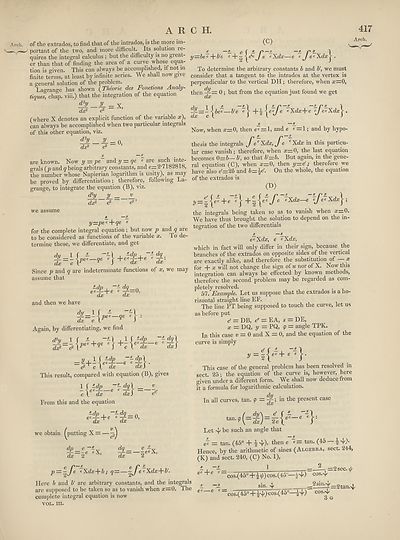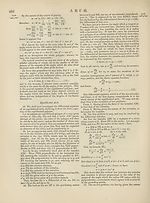Encyclopaedia Britannica > Volume 3, Anatomy-Astronomy
(425) Page 417
Download files
Complete book:
Individual page:
Thumbnail gallery: Grid view | List view

ARCH.
of the extrados, to find that of the intrados, is the more im- ( )
portant of the two, and more difficult. Its solution xe- x c ( —£ n *. 1
quires the integral calculus ; but the difficulty is no great- y—be^-^Ve c+H)eV Je c^dx—e c J ecXdx\.
er than that of finding the area of a curve whose equa¬
tion is given. This can always be accomplished, it not in
finite terms, at least by infinite series. We shall now give
a general solution of the problem. . . 7
Lao-range has shown (Theorie des Fonctions Analy-
tiques, chap, viii.) that the integration of the equation
d'2y
dy?
To determine the arbitrary constants b and b\ we must
consider that a tangent to the intrados at the vertex is
perpendicular to the vertical DH; therefore, when ;r=:0,
then 0 ; but from the equation just found we get
dx
-£ = x.
(where X denotes an explicit function of the variable x),
can always be accomplished when two particular integrals
of this other equation, viz.
d*y y_ - 0
dx1 (? ~~ ’
X —£
are known. Now y — ye and y — qe c are such inte¬
grals (p and q being arbitrary constants, and e=: 2-7182818,
the number whose Napierian logarithm is unity), as may
be proved by differentiation; therefore, following La¬
grange, to integrate the equation (B), viz.
dry y _ v
we assume
X_ —X_
yzzpec-\-qe c
for the complete integral equation; but now p and 9 aie
to be considered as functions of the variable x. lo de¬
termine these, we differentiate, and get
± = l{pe‘-qe ‘}+e^£+‘
dq
dx'
-dp .
ej+e
ax
^=0,
ax
md then we have
dy If -
dx c j
Again, by differentiating, we find
<Py ij -7I
^ = y-yIK‘+V ■q+cC dx]
= 2!+I{c7^_e“7j}.
(?— c l dx dx)
This result, compared with equation (B), gives
1 f Ldp dq\ v
cl dx dx) c-
From this and the equation
-dp , dq
ecA--\-e c 0,
dx dx
we obtain ^putting X = —
dp _c ~
c X,
dx 2
dq _ c
i=-2etX’
Since p and q are indeterminate functions of x, we may
assume that
^jL = -{be^—b'e +%\e\fe ^Xdx + e “fe^Xdx}.
Now, when «=0, then =1, and e ^ — 1; and by hypo¬
thesis the integrals f ecXdx,fe cXdx in this particu¬
lar case vanish; therefore, when a?=0, the last equation
becomes 0=6— b', so that b'=b. But again, in the gene¬
ral equation (C), when a;=0, then y=d; therefore _we
have also c'=26 and b=\c'. On the whole, the equation
of the extrados is
(D)
^ _ L ee q-e e c Xdx—e CJec Xrfx j-;
the integrals being taken so as to vanish when a;=0.
We have thus brought the solution to depend on the in¬
tegration of the two differentials
£. ——
ec Xdx, e c Xdx,
which in fact will only differ in their sign, because the
branches of the extrados on opposite sides of the vertical
are exactly alike, and therefore the substitution of x
for + x will not change the sign of u nor of X. Now this
integration can always be effected by known methods,
therefore the second problem may be regarded as com¬
pletely resolved.
57. Example. Let us suppose that the extrados is a ho¬
rizontal straight line EF.
The line FT being supposed to touch the curve, let us
as before put
d = DB, c" = EA, s — DE,
x = DQ, y = FQ, 9 = angle TPK.
In this case « = 0 and X = 0, and the equation of the
curve is simply
y=!{*'+*7}.
p — ^Je cXdx-\-b; q— — ^j'ecXdx-\-b
Here b and b' are arbitrary constants, and the integrals
are supposed to be taken so as to vanish when x=0 rru''
complete integral equation is now
vol. m.
This case of the general problem has been resolved in
sect. 25; the equation of the curve is, however, here
given under a different form. We shall now deduce from
ft a formula for logarithmic calculation.
In all curves, tan. <p in the present case
Let ^ be such an angle that
— X
e7 = tan. (45° + £ then e 7 = tan. (45 — £ ^).
Hence, by the arithmetic of sines (Algebra, sect. 244,
(K) and sect. 240, (C) No. 1),
*_ -£ 1 _ 2
ec-j-e <•■ =
The -
ec — e c —
' cos.(45° + ^<//) cos. (4o°-
sin. 4
cos.(45° + cos.(45°-
cos.-4/
_2sin.-4/_
COS.-vJ/
3 Gr
-i+)
=2 sec. \j/
2tan.4/
of the extrados, to find that of the intrados, is the more im- ( )
portant of the two, and more difficult. Its solution xe- x c ( —£ n *. 1
quires the integral calculus ; but the difficulty is no great- y—be^-^Ve c+H)eV Je c^dx—e c J ecXdx\.
er than that of finding the area of a curve whose equa¬
tion is given. This can always be accomplished, it not in
finite terms, at least by infinite series. We shall now give
a general solution of the problem. . . 7
Lao-range has shown (Theorie des Fonctions Analy-
tiques, chap, viii.) that the integration of the equation
d'2y
dy?
To determine the arbitrary constants b and b\ we must
consider that a tangent to the intrados at the vertex is
perpendicular to the vertical DH; therefore, when ;r=:0,
then 0 ; but from the equation just found we get
dx
-£ = x.
(where X denotes an explicit function of the variable x),
can always be accomplished when two particular integrals
of this other equation, viz.
d*y y_ - 0
dx1 (? ~~ ’
X —£
are known. Now y — ye and y — qe c are such inte¬
grals (p and q being arbitrary constants, and e=: 2-7182818,
the number whose Napierian logarithm is unity), as may
be proved by differentiation; therefore, following La¬
grange, to integrate the equation (B), viz.
dry y _ v
we assume
X_ —X_
yzzpec-\-qe c
for the complete integral equation; but now p and 9 aie
to be considered as functions of the variable x. lo de¬
termine these, we differentiate, and get
± = l{pe‘-qe ‘}+e^£+‘
dq
dx'
-dp .
ej+e
ax
^=0,
ax
md then we have
dy If -
dx c j
Again, by differentiating, we find
<Py ij -7I
^ = y-yIK‘+V ■q+cC dx]
= 2!+I{c7^_e“7j}.
(?— c l dx dx)
This result, compared with equation (B), gives
1 f Ldp dq\ v
cl dx dx) c-
From this and the equation
-dp , dq
ecA--\-e c 0,
dx dx
we obtain ^putting X = —
dp _c ~
c X,
dx 2
dq _ c
i=-2etX’
Since p and q are indeterminate functions of x, we may
assume that
^jL = -{be^—b'e +%\e\fe ^Xdx + e “fe^Xdx}.
Now, when «=0, then =1, and e ^ — 1; and by hypo¬
thesis the integrals f ecXdx,fe cXdx in this particu¬
lar case vanish; therefore, when a?=0, the last equation
becomes 0=6— b', so that b'=b. But again, in the gene¬
ral equation (C), when a;=0, then y=d; therefore _we
have also c'=26 and b=\c'. On the whole, the equation
of the extrados is
(D)
^ _ L ee q-e e c Xdx—e CJec Xrfx j-;
the integrals being taken so as to vanish when a;=0.
We have thus brought the solution to depend on the in¬
tegration of the two differentials
£. ——
ec Xdx, e c Xdx,
which in fact will only differ in their sign, because the
branches of the extrados on opposite sides of the vertical
are exactly alike, and therefore the substitution of x
for + x will not change the sign of u nor of X. Now this
integration can always be effected by known methods,
therefore the second problem may be regarded as com¬
pletely resolved.
57. Example. Let us suppose that the extrados is a ho¬
rizontal straight line EF.
The line FT being supposed to touch the curve, let us
as before put
d = DB, c" = EA, s — DE,
x = DQ, y = FQ, 9 = angle TPK.
In this case « = 0 and X = 0, and the equation of the
curve is simply
y=!{*'+*7}.
p — ^Je cXdx-\-b; q— — ^j'ecXdx-\-b
Here b and b' are arbitrary constants, and the integrals
are supposed to be taken so as to vanish when x=0 rru''
complete integral equation is now
vol. m.
This case of the general problem has been resolved in
sect. 25; the equation of the curve is, however, here
given under a different form. We shall now deduce from
ft a formula for logarithmic calculation.
In all curves, tan. <p in the present case
Let ^ be such an angle that
— X
e7 = tan. (45° + £ then e 7 = tan. (45 — £ ^).
Hence, by the arithmetic of sines (Algebra, sect. 244,
(K) and sect. 240, (C) No. 1),
*_ -£ 1 _ 2
ec-j-e <•■ =
The -
ec — e c —
' cos.(45° + ^<//) cos. (4o°-
sin. 4
cos.(45° + cos.(45°-
cos.-4/
_2sin.-4/_
COS.-vJ/
3 Gr
-i+)
=2 sec. \j/
2tan.4/
Set display mode to:
![]() Universal Viewer |
Universal Viewer | ![]() Mirador |
Large image | Transcription
Mirador |
Large image | Transcription
Images and transcriptions on this page, including medium image downloads, may be used under the Creative Commons Attribution 4.0 International Licence unless otherwise stated. ![]()
| Encyclopaedia Britannica > Encyclopaedia Britannica > Volume 3, Anatomy-Astronomy > (425) Page 417 |
|---|
| Permanent URL | https://digital.nls.uk/193762873 |
|---|
| Attribution and copyright: |
|
|---|---|
| Shelfmark | EB.16 |
|---|---|
| Description | Ten editions of 'Encyclopaedia Britannica', issued from 1768-1903, in 231 volumes. Originally issued in 100 weekly parts (3 volumes) between 1768 and 1771 by publishers: Colin Macfarquhar and Andrew Bell (Edinburgh); editor: William Smellie: engraver: Andrew Bell. Expanded editions in the 19th century featured more volumes and contributions from leading experts in their fields. Managed and published in Edinburgh up to the 9th edition (25 volumes, from 1875-1889); the 10th edition (1902-1903) re-issued the 9th edition, with 11 supplementary volumes. |
|---|---|
| Additional NLS resources: |
|

